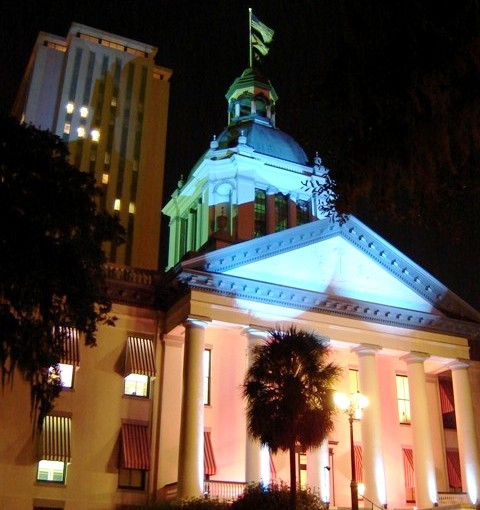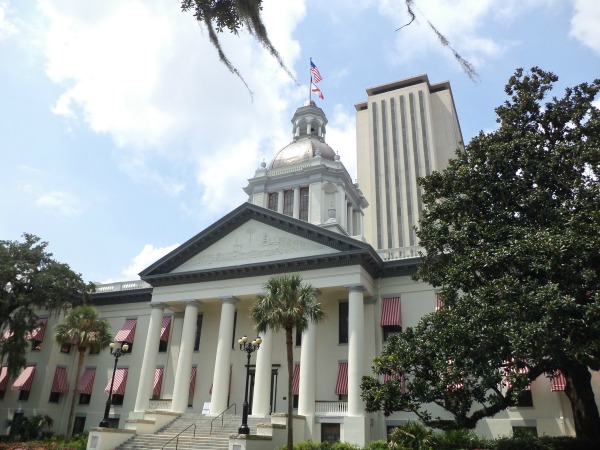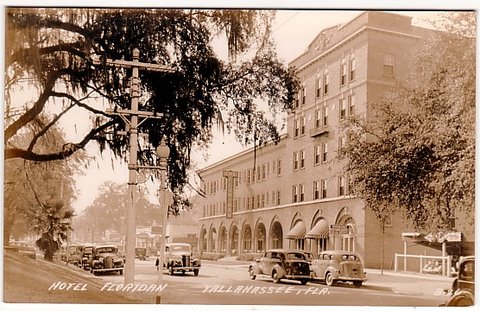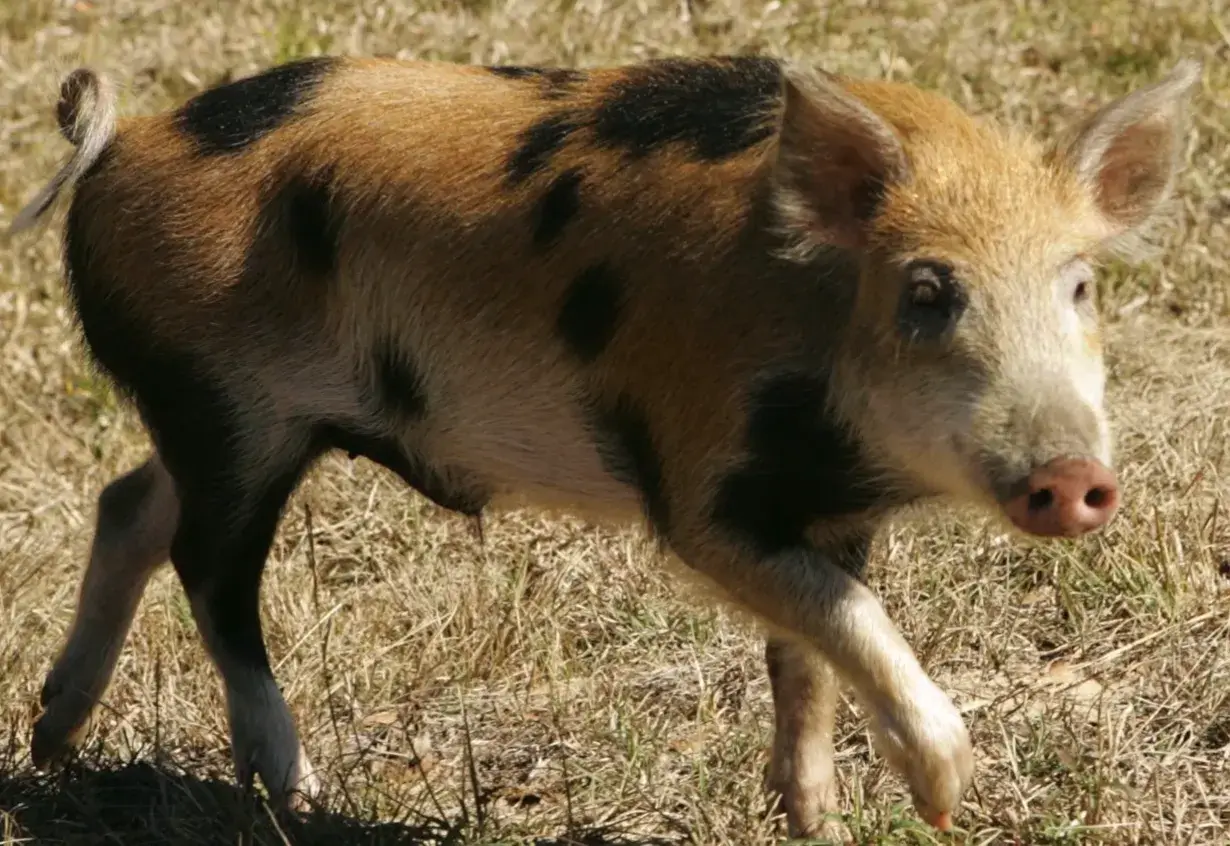- Home
- Florida Towns
- Tallahassee
TALLAHASSEE FLORIDA
By Mike Miller Updated July 1, 2023
Tallahassee Florida was first settled by Mississippian Indians, who were displaced in later years by the Apalachee tribe and then the Seminoles.
 Florida State Capitol
Florida State CapitolThe Spanish explorer Hernando de Soto and his troops occupied the area that is now Tallahassee in the winter of 1538. They established Mission San Luis de Apalachee to help provide labor and food for their colony of St. Augustine to the east.
The Mission was also strategically located about halfway between the Spanish settlements of Pensacola and St. Augustine.
After bouncing around under the Spanish, British and American flags, Florida finally became a Florida territory in 1821. Tallahassee was chosen as the territorial capital.
Tallahassee Florida Was Partly Owned By Lafayette
The Marquis de Lafayette, who was a hero of our Revolutionary War, made a tour of the United States in 1824. During the tour he was given 36 square miles of land by the U. S. Congress a thank you gift. The acreage included much of what is now Tallahassee.
Tallahassee remained the capital when Florida gained statehood in 1845. The Greek revival "Old Capitol" building was constructed just in time for the statehood ceremonies.
The Old Capitol building still stands in front of the modern (1977) 23 story capitol building where most of the work of the Governor and Legislature actually gets done.
Before the U.S. Civil War, Tallahassee was a slave, cotton and tobacco trading center. The city was in the center of a large plantation economy.
It was a thriving town, and several academic institutions were founded that became the beginnings of Florida State University and Florida A&M University.
At the end of the Civil War, Tallahassee had the distinction of being the only Confederate capital east of the Mississippi River that had not been captured by the Union Army.
Only one battle was fought near Tallahassee during the Civil War. The Battle of Natural Bridge took place a few miles south of the city in 1865.
 Florida State Capitol
Florida State CapitolAfter the Civil War, the end of slavery devastated the cotton and tobacco trade that Tallahasse had relied so heavily on.
Economic activity began to move away from Tallahassee to more southern regions of the state. Citrus, cattle and tourism became the new industries and left Tallahassee behind.
The plantations fell into disrepair and economic misery. Many of them were bought by rich Yankees to use as winter hunting reserves.
For 80 years after the Civil War, up until the end of World War Two, Tallahassee was a sleepy southern town that just happened to be the State capital.
Most people in town worked for State government or the universities.
 Hotel Floridan
Hotel FloridanIn the 1960's there were several attempts by politicians in central and south Florida to move the capital to Orlando.
It would have provided a more central location, but the movement was defeated and the State built the tall new Capital building in 1977.
It was a signal that Tallahassee was here to stay as the State capital.
Another signal was that the State converted the Old Capitol building into a museum rather than tearing it down. You can still visit it today.
Today it is a vibrant city of 199,516 people in Leon County, whose population is 297,211.
The rolling hills and canopied roads of Tallahassee and Leon County remind many people of more northern regions. It is after all way up in North Florida.
The economy of Tallahassee is still very much dependent on the payrolls of Florida State University, Florida A&M University, the State of Florida and all of the law firms and lobbyists who practice their trade in the capital city.
Leon County predictably votes Democrat in most elections because of the heavy registration of State employees.
THINGS TO DO IN TALLAHASSEE, FLORIDA
Florida State Capitol
400 S Monroe St, Tallahassee, FL 32399 | (850) 488-6167
A visit to Tallahassee isn't complete without exploring the Florida State Capitol. Offering stunning views from the 22nd-floor observatory and fascinating exhibits about Florida's government and history, the Capitol is a must-see for anyone interested in politics and history.
It's a favorite spot for those looking to gain insight into the workings of state government while enjoying panoramic views of the city.
Tallahassee Museum
3945 Museum Dr, Tallahassee, FL 32310 | (850) 575-8684
Set on 52 acres of breathtaking Florida land, the Tallahassee Museum is part outdoor nature center, part history museum, and part zoo. It offers an immersive experience into the region's natural and cultural heritage, with live animal exhibits, zipline tours, nature trails, and historic buildings.
It’s a perfect place for those seeking to connect with nature and learn more about the area's history in an interactive setting.
Mission San Luis
2100 W Tennessee St, Tallahassee, FL 32304 | (850) 245-6406
Experience the rich cultural tapestry of Spanish and Apalachee life in the 17th century at Mission San Luis. This living history museum invites visitors to explore a reconstructed Spanish mission through the eyes of both the colonists and the Native Americans.
It’s a great spot for history enthusiasts looking to immerse themselves in the story of early Florida.
Alfred B. Maclay Gardens State Park
3540 Thomasville Rd, Tallahassee, FL 32309 | (850) 487-4556
Renowned for its stunning ornamental gardens, the Alfred B. Maclay Gardens State Park is a haven of tranquility and beauty. Visitors can enjoy year-round blooms, picturesque brick walkways, and a reflection pool.
Picnic tables and grill are available. The gardens are also a U.S. historic district known as the Killearn Plantation Archeological and Historic District.
It's an ideal destination for those looking to enjoy a leisurely stroll or a picnic in a beautiful, serene setting.
Cascades Park
1001 S Gadsden St, Tallahassee, FL 32301 | (850) 891-3866
Cascades Park is a vibrant community gathering place offering scenic walking trails, an interactive water fountain, and an amphitheater hosting a variety of performances.
The park's prime location and diverse amenities make it a great spot for a family outing or a relaxing day outdoors. It is a Nationally Registered Historic Place. Dogs are welcome.
Railroad Square Art District
661 Railroad Sq, Tallahassee, FL 32310 | (850) 224-1308
Immerse yourself in the artistic spirit of Tallahassee at the Railroad Square Art District, a WWII-era industrial warehouse park turned urban art district.
This creative hub is home to dozens of art studios, galleries, and shops, where you can explore local art, attend workshops, and meet the artists. There are also vintage clothing and thrift stores, and even a vintage pinball arcade and indoor rock climbing gym.
There are plenty of options for dining/refreshments including Black Dog Cafe on the Square (coffee, gourmet pops, and more), the Crumbox Gastgarden (only cafe in town built out of a real railroad caboose), and the Railroad Square Craft House, serving pub food and craft beer in a colorful outdoor art garden.
Tallahassee Automobile Museum
6800 Mahan Dr, Tallahassee, FL 32308 | (850) 942-0137
Car enthusiasts will be thrilled to visit the Tallahassee Automobile Museum, which houses one of the largest collections of antique cars and memorabilia in the Southeast.
From classic Fords to rare collectibles, the museum offers a fascinating journey through automotive history. It’s a must-visit for anyone with an appreciation for classic cars and Americana.
Our Facebook page has more than 130,800 followers who love off the beaten path Florida: towns, tourist attractions, maps, lodging, food, festivals, scenic road trips, day trips, history, culture, nostalgia, and more.
By Mike Miller, Copyright 2009-2025
Florida-Back-Roads-Travel.com
Florida Back Roads Travel is not affiliated with or endorsed by Backroads, a California-based tour operator which arranges and conducts travel programs throughout the world.
